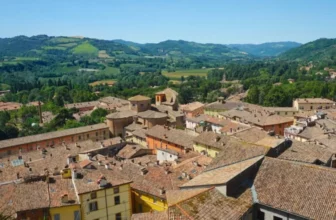The south of Italy is not only famous for it’s hospitality, the beauty of its landscape and the fabulous food (make sure to try some buffalo Mozzarella, it’s the best in the world) but also for its long and rich history, especially Pompeii And Paestum.
Romans, Greek, Lycans, Staufer and Moors all left their mark in ancient Italy. Pompeji, one of the world’s most famous archaeological sites, lies just outside Naples, and a little further down the coast is Paestum, both of them a must see for everyone who is at least a little bit interested in ancient history.
In the following article I want to share with you some photos from both of these amazing sites and try to make a comparison, so if you only want to spend one day polishing your cultural appeal you can make an informed choice as to what’s more interesting for you!
Looking for a beautiful beach destination in Italy? Be sure to visit beautiful Puglia. Or if you are planning an off-the-beaten track journey across Italy, read this post about the lesser known spots in Italy. For the best tour of Cinque Terre, I recommend Ciao Florence! For anyone heading to see ancient Rome, here how to skip the queues.
The Grand Tour in Campania
Pompeii
Founded by the Oscans on the fertile slopes of Mount Vesuvius around 600BC, Pompeii came under Roman dominance about 200 years later, before it was finally colonised in 80 BC after the city took part in a revolt against Rome. With an estimated 10-12.000 citizens (including slaves) it was a big city and commercial hub at the time, when it was buried beneath 6m of volcanic ash when Vesuvius erupted violently in 79AD.
Only 17 years earlier a major earthquake – probably around 6 on the Richter-scale – destroyed parts of the city, spurning talk of abandoning the site altogether. Instead, they decided to rebuild and make the place even better and more beautiful than before.
After the eruption Pompeii was forgotten for a millennium and a half. It was first rediscovered in 1599 by a Spanish engineer in the pay of the Bourbons who was digging a channel from the river Sarno. Interestingly enough Domenico Fontana decided to rebury and even paint over some of the sexually explicit frescoes he found, presumably to save them for later times. It might be though that he was outraged by the inscriptions he found himself, after all it was the height of counter-reformation. About a 150 years later targeted excavations started and the full extent of the site was discovered.
Today around 70 hectares have been dug out, with hundreds of houses for the poor, huge villas with fountains and gardens, temples, theatres, bath-houses and uncounted artifacts. The most disturbing among these are the petrified bodies of people caught in a tsunami of hot ash, huddled together or lying in a corner of their house with their hands above their heads, as a futile gesture of protection. Lovers hugging each other in their last moments of life, cats and dogs caught midstride. I can’t even begin to imagine the horror of death like that, the disorientation, the fear.
Pompeii is like a snapshot of Roman society in the first century, freezing time in a random moment and giving us a unique insight into everyday life. When I visited sadly a lot of the big compounds were closed to the public, but there was still enough to see. If you’re really into it, you definitely need a lot of time to discover all. I spent nearly a whole day on site and still had the feeling that I just started to scratch the surface.
Pompeii is huge and wonderful place to dive into Roman culture and society, take an audio-guide. Open all rear, admission is 11€ (5,50 if you’re a student or senior)
Paestum
A bit further down the coast lies Paestum. As in the case of Pompeii in its heyday it was much closer to the sea, due a lower sealevel today compared to 2000 years ago. In a way I was even more impressed than in Pompeii for three reasons; the site feels a lot like a park, with less people, it has trees and shade and somehow looked more real to me, even though I couldn’t begin to explain this feeling. Another reason is the fact, that three major cultures left their mark here, the Lucans were first replaced with a Greek colony before that became a Roman settlement, all the while retaining properties of the respective predecessors. Lastly, it has a museum on site, while all the statues and everyday items from Pompeii are in the National Museum in Naples.
Paestum is a lot smaller than Pompeii and way less preserved. Although it was forgotten even longer a lot was destroyed over the millenia. For centuries a temple ruin was visible above ground but no one knew anything about it, so the Then-ruling Bourbons built a road beside it in the 18th century – right on top of the amphitheater, through it for all practical purposes.
Following excavations were not really up to modern standards, and the people who were supposed to save these rich archaeological finds for the future have been destroying them. Even in the 20th century houses were built on top of the site. Poverty in the South was so big, it seemed more important to create jobs and affordable housing.
Smaller and not as crowded as Pompeii, with a really amazing museum on site that shows hundreds of statues and graves, Paestum is more of a ruin in the classical sense.
Editors note: Thanks to German travel blogger Sascha möllering from the brilliant 60Seconds blog for writing this brilliantly informative post. Really makes me want to spend some time in Italy! All photos were taken by and belong to him. 🙂























